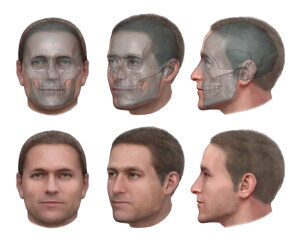aInstitute of Ethnology and Anthropology RAS, Moscow, Russia
bResearch Institute and Museum of Anthropology, Moscow State University, Moscow, Russia
#E-mail: rasskazova.a.v@mail.ru
Keywords: craniofacial reconstruction, composite portrait, palaeoanthropology, physical anthropology, urban population, craniology, digital 3D skull models.
The article presents a new method for visualizing paleoanthropological data – a generalized portrait-reconstruction based on craniological data. A generalized or composite portrait is widely used in studying modern population; it provides generalized visual information about the facial morphology of any population sample. Palaeoanthropological morphological studies also rely on group data, but often lack summarizing visual information. The method of craniofacial reconstruction provides reliable portraits of individuals from ancient groups. However, individual craniofacial reconstructions do not give insight into the morphology of the entire group or the difference between groups. The proposed method creates a craniofacial reconstruction based on a generalized three-dimensional model of the skull, built on the mean values of the coordinates of landmarks placed on the surfaces of models of all skulls in the sample. Testing this method on two morphologically different craniological samples showed that the final summary model reproduces the specific facial morphology of each group and the selected number of landmarks is sufficient. A generalized portrait-reconstruction illustrates morphological features and differences between paleoanthropological groups, and allows visual comparisons with modern populations.
DOI: 10.31857/S0869606323030170, EDN: KAJHLU








